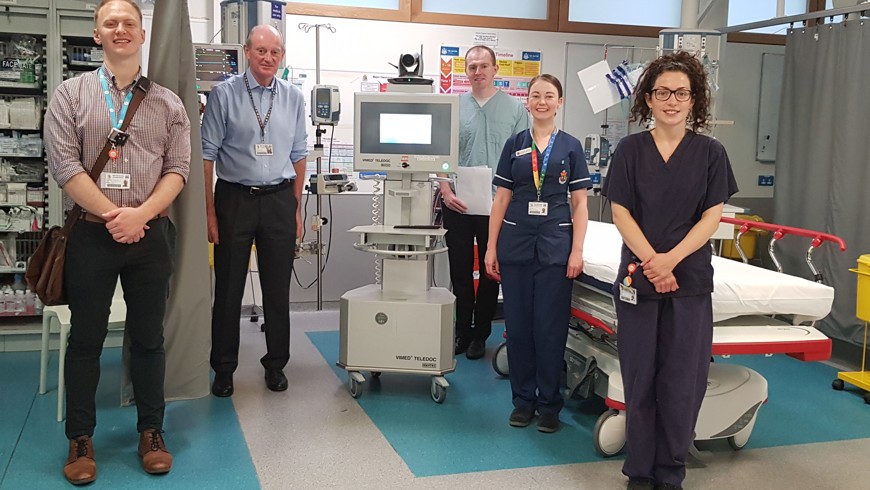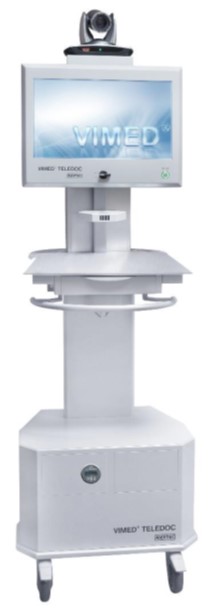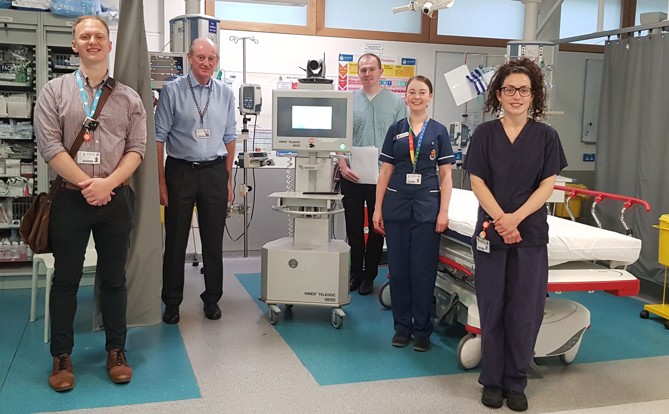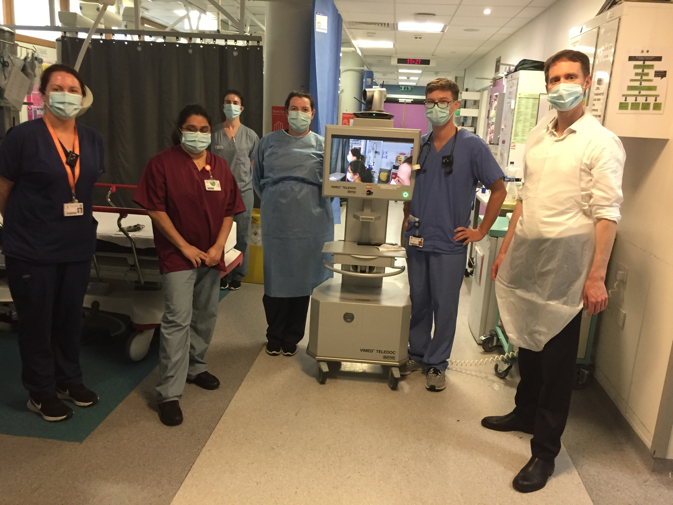
How the TRASNA system assisted in the assessment and treatment of Covid-19 patients.
TRASNA Stroke Telemedicine
Background
The Telemedicine TRASNA system allows medical teams to assess a patient remotely via a Teledoc - a robot-like device on a mobile stand containing a remotely controlled camera and a microphone, which allows effective communication between the medical team, the patient and/or the patient’s family.
The Teledoc mobile stand has mobility and height adjustment which allows the camera and monitor to be adjusted to optimal examination position, whilst the camera on top of the Teledoc can rotate and zoom in and out for maximum clarity.
The screen allows for two-way video and audio between the consultant and the patient.
A version of the Telemedicine TRASNA HD system is currently operational in both Tallaght and Naas hospitals which practice a combined stroke personnel rota after-hours.
OoCIO and TRASNA
The OoCIO TRASNA Project Management team are responsible for the day to day running of the project working in collaboration with Clinical Leads, Colleagues in OoCIO, Local Hospital IT staff and the Vendor.
TRASNA HD Refresh Project
The aim of the TRASNA HD hardware refresh project is to replace the existing video conferencing system with new technology that provides HD quality video, much improved audio and better usability through seamless secure networking. The refresh project will include the existing stroke networks and will be extended into other areas as required.
The upgrade also includes a software solution to allow contemporaneous note taking and will provide remote access to NIMIS on the consultant’s Surface Pro devices.
The TRASNA HD Refresh project proposes to replace the existing end of life hardware in Tallaght and Naas with the new TRASNA HD technology and implement in the following stroke networks:
- Tallaght and Naas system upgrade
- St. Luke’s hospital in Kilkenny will join the Tallaght/Naas network as a new implementation.
- Mater Misericordiae University Hospital and Cavan General Hospital new implementations
St. Luke’s Hospital Kilkenny went live on the 18th th of December 2019. This new site implementation was used to evaluate the system and resolved any issues detected prior to further implementations.
TRASNA HD Refresh Project Plan
The plan was to upgrade the system in Tallaght and Naas during January and February 2020 and set up the new sites in the Mater/Cavan network in March and April 2020.
The Teledocs were commissioned at each site during November 2019 with a test and backup Teledoc stationed in the HSE Technology office HSE Cork.
Prior to Go Live, each consultant is issued with a Surface Pro tablet, a Mifi device (a wireless router that acts as mobile Wi-Fi hotspot) and a home router. This equipment is configured and tested for the hospital network group to the ensure the consultants have access to the correct Teledoc units. User documentation and training are provided by the vendor and project team.
Configuration and set up of the devices for the Tallaght/Naas implementation was in progress at the onset of Covid-19.
Change of Use for Covid-19
Mater/Cavan Hospitals
With the onset on Covid-19, the Mater team requested an acceleration of the TRASNA implementation. In the interest of patient and medical staff safety, the Teledoc could be used by multidisciplinary teams for the remote assessment of Covid-19 patients.
The OoCIO TRASNA team deployed and tested the Teledoc which was connected via the Mater Wi-Fi network, liaised with the vendor, networks and infrastructure and the local IT team to resolve connectivity issues. Normally each consultant is issued with an individual Surface Pro tablet, Mifi device (a wireless router that acts as mobile Wi-Fi hotspot) and a home router device to connect to the HSE secure network and work remotely. However, in this instance, the OoCIO TRASNA team set up and issued Surface Pro tablets with a generic logon account and a Mifi device to allow the multidisciplinary medical teams access to the system. The OoCIO TRASNA team provided training and support to the multidisciplinary medical teams.

L to R: Dr. Eoghan Donlon, Stroke Registrar, Prof Seán Murphy, Stroke Consultant, Dr. Desmond O'Donnell, Stroke Registrar
Caroline Deegan, Stroke CNS, Laura Hutchinson, Staff Nurse ED

ED Staff at the Maher using Teledoc
This allowed the medical teams within the hospital to assess the patient remotely, thus delivering efficiencies in patient assessments, whilst simultaneously reducing risk of infection and reducing the need for PPE.
The remote Covid-19 patient assessment via the Teledoc was very beneficial for the Mater multidisciplinary medical teams and this resulted in a request for additional remote access points to be set up within the hospital.
The OoCIO TRASNA project team responded to this request by rebuilding, configuring and testing two older laptops. Each of the laptops were setup with generic logon accounts for use by the multidisciplinary medical team. The laptops were installed at strategic points within the hospital for easy access to the Teledoc.
The feedback from the Mater medical team has been very positive and the advantage of using the Teledoc for Covid-19 assessment were realised.
Following the successful Mater implementation, the Cavan hospital implementation went live for Covid-19 patient assessment. As the Mater and Cavan hospitals are on the same TRASNA hospital network, the further enhancement of combined patient assessment via the software on the Surface Pro over the HSE secure network can now take place.
"Staff found this ability to constantly review patients while not having to always have a physical presence at the bedside extremely beneficial. Patients interacted well with the dynamic software. We were able to limit the amount of PPE required for medical staff and also the duration of time of potential exposure to infected patients and the physical discomfort of wearing PPE for prolonged periods. Thankfully we have had very small numbers of our ED medical and nursing staff infected with COVID-19 and I'm sure that the Telemedicine unit has played a role in this in some way. I may also express thanks at the speed that the system was setup and activated. Having discussed this with Neurology colleagues in the Mater, the timeliness to have this up and running was admirable" - Dr Vinny Ramiah FRCEM, MRCPI, DCH, Consultant in Emergency Medicine, Mater University Hospital
Tallaght Hospital
The new Teledoc in Tallaght hospital has been installed and tested and is ready for deployment.
Benefits for Covid-19
- Patient assessment time was reduced, facilitating quicker access to care
- Facilitating more assessments to over a shorter period of time
- Reduces stress for the medical teams by improving effectiveness
- Telemedicine is appropriate in the ED for more than stroke and neurological assessment, as evidenced by the experience of the Mater and Cavan teams
- Remote working enhances patient and staff safety where risk of exposure to infection is high
- The acceleration of the Mater/Cavan TRASNA implementation for Covid-19 has brought forward the Go Live dates by approximately ten weeks
- No compromises occurred in getting the system operational, as maintaining a credible standard was an aim of this project, although achieving this was not without its challenges
